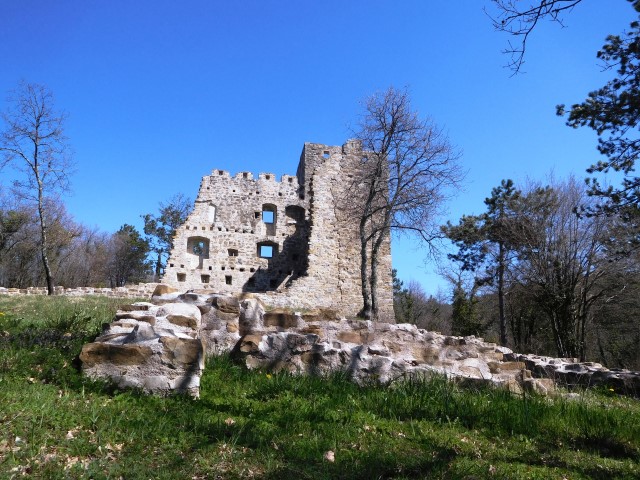Former pictures 2017-04-09.

Name: Walderstein’s castle
Place: Paz – (Cerovlje)
Coordinates: 45.29040 N – 14.09336 E
Former pictures 2017-04-09.

Name: Walderstein’s castle
Place: Paz – (Cerovlje)
Coordinates: 45.29040 N – 14.09336 E
The name of the castle was in the 11th century St. Martin, and in the 16th century Sabec. The castle is devastated during the Uskok war (1615- 1617).
From the top of the tower you see the the castle of Belay, built after the destroy of the Pessort castle.
The church of the St. Martin is built in 1367.
Name: Possert, Sabeč and St. Martin
Place: Paz – (Cerovlje)
Coordinates: 45.27431 N – 14.10347 E

Name: Medieval themepark Sanc. Michael
Place: Raponji – (Svetvinčenat)
Coordinates: 45.0795 N – 13.8590 E
The medieval castle Kršan was the first time mentioned in 1274.
In the 15th century it belonged to the noble family of Kerstlein de Pisino. The last owner was the nobleman Giovanni Tonetti from Plomin, known as “The red count”.
In the Mausoleum on the cemetery of Plomin are the tombs of the family Tonetti.

Place : Kršan
On a rocky hill near the mouth of the Mirna are the ruins of the castle St. Juraj from the Middle Ages. Presumably is this place also of prehistoric significance. There is still a wall of 40 meters long, 5-6 meters high and about 1 meter thick.
The church with the same name was built in the 12th century.

Name castle/ church: St Juraj
Place: Nova Vas – Bertonigla
The castle Črni Kal was mentioned in the 11th century and called “Town” or “Old Town” and stands on a 30 meter high cliff and could be reached by a 4 meter long drawbridge. The fortress is situated on the main road through Rižana valley towards Klanec, between the Adriatic coast and the interior, on the border between the Venetians and Habsburg interests. It was a resting place for trader man and travellers.

Place: Črni Kal – (Koper)
Dvigrad is located in the Lim Bay.
In the first half of the 17th century Dvigrad is destroyed by Uskoci (war between Austria and Venice) and only a few decades later by plaque, so that life in Dvigrad completely died.
In the Roman period the settlement was named “Duo Castra like Dvigrad now. Built in the 6th century and restricted in the beginning of the 17th century when Dvigrad was the border between Poreč and Pula.
In the Middle ages were two castles on two opposite hills, named Parentino and Montecastello. Parentino was destroyed in the 14th century and today we can see the the ruins of Montecastello.
On the top of the rock is the church of St. Sophia from the 11th century. Built on the place of an older church from the 7th century. The ruins we see to day date back into the 13th century.
In the neighbour of the ruins od Dvigrad is located the cemetary church St. Mary of Lakuc

Place: Dvigrad – (Kanfanar)
This castle is located in the valley of the river Rasa to defend the border of the County of Pazin. Built in 1300 by Frederica Eberstein and in the 15th century became the family Walderstein the ownership. It is rebuilt in 1570 by Messaldo Barbo and in 1695 sold to Prince Auersperg. During the 18th century the castle of Paz lost its strategic importance.

Name: Walderstein’s castle
Place: Paz
Built: 1300